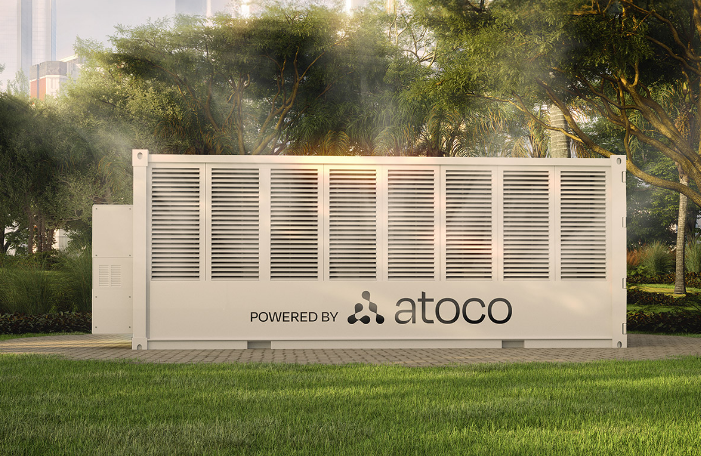
原标题:彭博推送 | 搜集空气就能产生干净水源啦!
单词
dislodges 强行去除
condenser 冷凝器
beaker 烧杯
arid 干旱
carbon footprint 碳排放
exacerbating water shortage 加剧了水资源短缺
water treatment plants 水处理厂
knock something offline 使得 XXX 停止工作
has an edge 拥有优势
reticular chemistry 网状化学
译文
Tardis 医生,为了获取水
作者 Todd Woody
南加州的一家仓库作为实验室了,Heng Su,作为一名科学家,揭开一项足以改变世界的方案,用于解决全球水危机。
一个小目标是为了看上去没那么厉害,由一堆白色风扇组成,组装起来是个很小的、很土的辐射器。然而,Su 量产这一小装置的时候,却默默地几秒之内变重了。几分钟之后,越来越重,因为装置聚集了水分子,还不可见,主要从周围的空气中聚集。
几英尺之外,有四台采集水的机器,一个塑料大机器,含有一个像鸟窝一样的透明区域。暖空气强行从空气搜集装置上剥离 H2O,冷凝器专用于将水蒸气转变为液体,然后滴入烧杯。
该项技术,称为有机金属框架(metallic organic frameworks,MOFs),并不要电力,也能生产水,只要阳光充分。有一家驻扎在 Irvine 的创业公司 Atoco,他们看好该技术,认为可以改善未来干旱的情况。
这项出自于实验室的原型,只能产生几毫升水,随着科学家不断完善技术。该公司计划建造能商业化的版本,能每天为一个社区生产几千升的超纯水(ultrapure water)。这个水的量,是家居空调可以产水的量。
“你可以从任何地方的空气中挤出水,一年中任何时间,无论湿度如何,也无需计算‘碳排放’”,Omar 说到,这个人 2021 年创立了 Atoco,也是 UCBerkeley 化学教授,是 MOFs 先锋。
世界一半人口经历着缺水,25% 经历着严重缺水,依据 2024 年联合国分析。甚至在富裕如加州的地方,该州吹嘘是全世界第五大经济体,几乎有 100 万居民缺乏获得干净水的渠道,一项 6 月的报告显示。
气候变化导致热浪和干旱,同时,加剧了全世界范围的水资源短缺。无论贫穷或富有,都经历更紧张的缺水,和更频繁的风暴,这些风暴能够使得水处理厂停产。
然而,即便是最干旱的天空都含有水。美国地理调研组估计,大气层含有 1.29 万立方公里的水,这些水相当于世界大湖的水的量的 14%。MOFs 能够提供独特方式,获取其中一部分(水)。
就像 Tardis 医生说的,这个材料或方法,其内在会更丰富。一克 MOF (这里来看,MOF 是一种描述空气面积的方式)能够拥有一个足球场的表面积。我们这样思考,Atoco CEO 说到,如果你拿出一张 A4 纸,尽量弄皱。现在这团纸只有原来的一部分(面积),但是它保持着相同表面积,只是被折叠了。评注:这句话用类比的方式,解释了 MOFs 工作原理。
这是 Acoto 在分子层面的工作,工程内容是用多孔腔填满纳米级别的晶体结构(crystalline structures)。这种做法,即 MOF 用特殊元素制作,特殊在能吸收特别的分子,例如 H2O。
其他创业公司,正在开发 MOF,专用于大气层水的捕捉。Acoto 拥有前沿优势(has a edge):Yaghi 开发了材料,有些人还在完善它们,同时在网状化学(reticular chemistry)领域有所建树。
Taha 说到,“Yaghi 过去十年的进步,使得我们在竞争中国领先”。
他拒绝透露,Atoco 何时让他们研发的技术上市,但强调:“并不会太慢”以及,他对于潜在市场也很有想法:任何人都能“拥有持续的、稳定的、干净的水源,以及并不想依靠政府制造的水”。
原文
Doctor Who’s Tardis — for water
By Todd Woody
At a laboratory in a Southern California warehouse, scientist Heng Su unveils what could be a world-changing solution to the global water crisis.
The small handheld object looks unremarkable, consisting of stacked white fins that resemble a miniature old-fashioned apartment radiator. But when Su puts the device on a scale, it silently gains weight within seconds. As the minutes pass, it gets heavier and heavier. That’s because the gadget is invisibly gathering water molecules from the surrounding air.
A few feet away, four of the water harvesters sit inside a plastic enclosure shaped like a transparent birdhouse. The warm air inside dislodges the H2O molecules from the harvesters and a condenser transforms the water vapor into liquid, which is dripping into a beaker.
The technology, called metallic organic frameworks (MOFs), doesn’t require electricity and can produce water with just ambient sunlight. It’s Irvine-based startup Atoco’s vision for how to provide water in an increasingly arid world.
This is a lab prototype designed to only produce a few milliliters of water as scientists work to perfect the technology. The company plans on building a full-scale commercial version that could produce thousands of liters of ultrapure water a day for a community. A unit the size of a residential air conditioner could supply water to your home.
“You can harvest water from air anywhere in the world, at any time of the year regardless of the level of humidity, without a carbon footprint,” says Omar Yaghi, who founded Atoco in 2021 and is a chemistry professor at the University of California at Berkeley who pioneered MOFs.
Half the world’s population experiences water scarcity and 25% endure extremely high levels of water stress, according to a 2024 United Nations analysis. Even in a wealthy place like California, which boasts the world’s fifth-largest economy, nearly a million residents lack access to clean drinking water, a June report found.
Climate change-fueled heat waves and droughts, meanwhile, are exacerbating water shortages across the world, sparing neither rich nor poor, and more intense and frequent storms can knock water treatment plants offline.
But even the driest skies contain water. The US Geological Survey estimates that the atmosphere contains 12,900 cubic kilometers of water or about 14% of what’s found in the world’s lakes. MOFs offer a unique way to harvest some of it.
Like Doctor Who’s Tardis, the material is bigger on the inside. A gram of MOFs can have the surface area of a soccer field. Imagine, says Atoco Chief Executive Officer Samer Taha, you take a piece of paper and crumple it as much as you can. It’s now a fraction of its original size but retains the same surface area within the folds.
That’s what Atoco is doing on the molecular level, engineering nanoscale crystalline structures filled with porous cavities. Its MOFs are made of elements that attract specific molecules, such as H2O.
Other startups are developing MOFs for atmospheric water harvesting. Atoco has an edge, though: Yaghi developed the material and has continued to perfect it while working in a field known as reticular chemistry.
“The advances that Professor Yaghi has made over the past decade keep us ahead of the competition,” says Taha.
He declined to say when Atoco would bring its technology to market but notes “it’s not far.” And he has big ideas for the potential market: It’s anyone “that wants to have a consistent, stable and pure water supply and doesn’t want to rely on water coming from the government.”
原文链接
长按/扫码,有您的支持,我们会更加努力!


|
